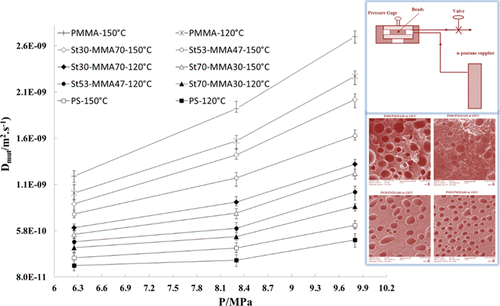当前位置:
X-MOL 学术
›
J. Chem. Eng. Data
›
论文详情
Our official English website, www.x-mol.net, welcomes your
feedback! (Note: you will need to create a separate account there.)
Experimental and Numerical Analyses of n-Pentane Solubility and Diffusivity in Polystyrene/Poly(methyl methacrylate) Blends
Journal of Chemical & Engineering Data ( IF 2.0 ) Pub Date : 2020-08-28 , DOI: 10.1021/acs.jced.0c00444 Hamidreza Azimi 1 , Davoud Jahani 2 , Mohammadreza Nofar 3
Journal of Chemical & Engineering Data ( IF 2.0 ) Pub Date : 2020-08-28 , DOI: 10.1021/acs.jced.0c00444 Hamidreza Azimi 1 , Davoud Jahani 2 , Mohammadreza Nofar 3
Affiliation

|
The solubility and diffusivity of n-pentane in blends of a low-molecular weight polystyrene (PS) and a high-molecular weight poly(methyl methacrylate) (PMMA) were investigated through experimental and numerical analysis. The Sanchez–Lacombe (SL) equation of state was used to evaluate the swelling behavior of n-pentane-impregnated blends. The Areerat model was also used to predict the diffusion coefficient of n-pentane. A good agreement between the experimental and numerical analyses was observed. The results revealed that the increase in pressure increased the n-pentane solubility and diffusivity coefficient in all systems. The increase in temperature also increased the n-pentane diffusivity coefficient; however, the solubility of n-pentane in blends was suppressed with temperature. This occurred when the n-pentane solubility and diffusivity were noticeably higher in blends with higher PS contents. This was most likely due to the lower molecular weight of PS than PMMA which could facilitate the diffusion and dissolution of n-pentane molecules. Moreover, the higher affinity of nonpolar n-pentane and styrene units could also cause higher dissolution of n-pentane in systems with higher PS contents. The foaming behavior of the blends also showed that a bimodal cellular structure appeared in foamed blend with a similar large cell population but in different populations and sizes of the smaller cells. This was while the growth of the smaller cells seemed to be easier in blends with a higher PS content because of the dissolution of a higher amount of dissolved n-pentane, although saturation temperature also played a determinative role on the foaming behavior of the blends.
中文翻译:

正戊烷在聚苯乙烯/聚(甲基丙烯酸甲酯)共混物中的溶解度和扩散率的实验和数值分析
通过实验和数值分析研究了正戊烷在低分子量聚苯乙烯(PS)和高分子量聚(甲基丙烯酸甲酯)(PMMA)共混物中的溶解度和扩散性。Sanchez-Lacombe(SL)状态方程用于评估正戊烷浸渍共混物的溶胀行为。Areerat模型也用于预测正戊烷的扩散系数。实验和数值分析之间观察到良好的一致性。结果表明,在压力的增加而增加的Ñ中的所有系统-戊烷的溶解度和扩散系数。温度的增加也增加了Ñ-戊烷扩散系数;然而,正戊烷在共混物中的溶解度随温度而受到抑制。此发生时的Ñ戊烷的溶解度和扩散率在具有较高含量PS共混物明显更高。这很可能是由于PS的分子量低于PMMA,这可以促进正戊烷分子的扩散和溶解。此外,非极性正戊烷和苯乙烯单元的较高亲和力也可能导致n的较高溶解度。-戊烷在PS含量较高的系统中。掺混物的起泡行为还表明,在具有相似大泡孔数量但较小泡孔的不同人口和大小的泡沫掺混物中出现了双峰孔结构。这是在较高PS含量的共混物中,由于溶解了更多量的正戊烷而使小孔的生长似乎更容易,尽管饱和温度也对共混物的起泡行为起决定性作用。
更新日期:2020-09-10
中文翻译:

正戊烷在聚苯乙烯/聚(甲基丙烯酸甲酯)共混物中的溶解度和扩散率的实验和数值分析
通过实验和数值分析研究了正戊烷在低分子量聚苯乙烯(PS)和高分子量聚(甲基丙烯酸甲酯)(PMMA)共混物中的溶解度和扩散性。Sanchez-Lacombe(SL)状态方程用于评估正戊烷浸渍共混物的溶胀行为。Areerat模型也用于预测正戊烷的扩散系数。实验和数值分析之间观察到良好的一致性。结果表明,在压力的增加而增加的Ñ中的所有系统-戊烷的溶解度和扩散系数。温度的增加也增加了Ñ-戊烷扩散系数;然而,正戊烷在共混物中的溶解度随温度而受到抑制。此发生时的Ñ戊烷的溶解度和扩散率在具有较高含量PS共混物明显更高。这很可能是由于PS的分子量低于PMMA,这可以促进正戊烷分子的扩散和溶解。此外,非极性正戊烷和苯乙烯单元的较高亲和力也可能导致n的较高溶解度。-戊烷在PS含量较高的系统中。掺混物的起泡行为还表明,在具有相似大泡孔数量但较小泡孔的不同人口和大小的泡沫掺混物中出现了双峰孔结构。这是在较高PS含量的共混物中,由于溶解了更多量的正戊烷而使小孔的生长似乎更容易,尽管饱和温度也对共混物的起泡行为起决定性作用。











































 京公网安备 11010802027423号
京公网安备 11010802027423号